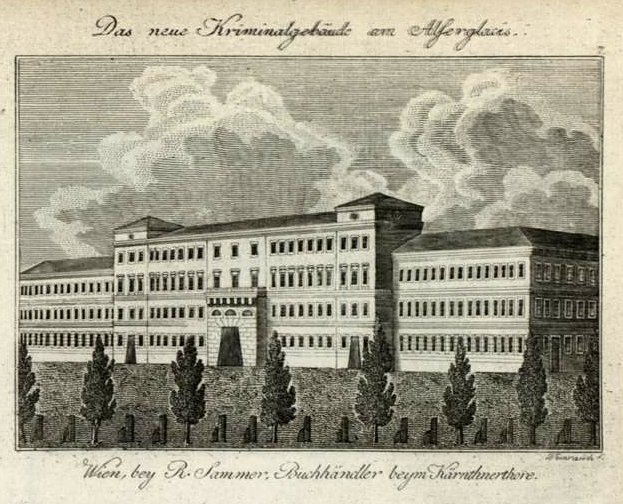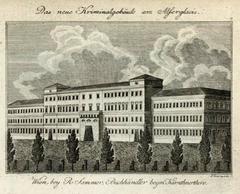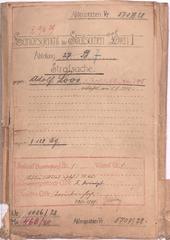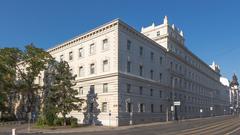
Landesgericht für Strafsachen Wien: Visiting Hours, Tickets, and Travel Guide
Date: 14/06/2025
Introduction
The Landesgericht für Strafsachen Wien (“Vienna Regional Criminal Court”), widely known as the “Graues Haus” (Grey House), is a monumental symbol of Austria’s judicial history and a site of significant remembrance. Located in Vienna’s Josefstadt district, it not only serves as the country’s largest criminal court but also as a memorial to the victims of Nazi injustice. The building’s impressive 19th-century architecture, inspired by Tuscan Renaissance palaces, reflects both its historical gravitas and its enduring role in Austria’s legal system.
Visitors can explore the court’s layered past—from its medieval roots through Habsburg reforms, its dark Nazi-era chapter, and its modern transformation into a center for justice and education. Guided tours and memorial exhibitions offer insights into Austria’s legal evolution and the importance of upholding human rights. Conveniently situated near other key Vienna attractions, the Landesgericht is both a destination for historical reflection and an integral part of the city’s cultural heritage.
This guide provides clear, detailed information on visiting hours, ticketing, accessibility, must-see features, and practical travel tips to help you make the most of your visit. For current updates and tour reservations, always consult the official court website and the Austrian Association for Legal Linguistics.
Table of Contents
- History of the Landesgericht für Strafsachen Wien
- Architectural Design and Features
- Cultural Significance and Memorialization
- Practical Visitor Information
- Judicial Structure and Function
- Frequently Asked Questions
- Plan Your Visit & Additional Resources
- References and Official Links
1. History of the Landesgericht für Strafsachen Wien
Origins and Early Development (1440–1839)
The story of Vienna’s criminal justice system begins at the Bürgerschranne on Hohen Markt 5, which served as the city’s principal criminal courthouse from 1440 to 1839. In 1773, Emperor Joseph II merged local and regional courts to form the “Kriminalgericht,” but by the early 19th century, the facilities were outdated, prompting plans for a new structure (Wikipedia).
Construction of the “Graues Haus” (1839–1850)
Construction commenced in 1839 under architect Johann Fischer, who was inspired by the Renaissance palaces of Florence. The imposing new building, completed in 1850, measures 223 meters in length and covers a 21,872 m² site. Its fortress-like character, multiple wings, courtyards, prison hospital, and chapel embodied the 19th-century approach to justice (Austria-Forum).
Expansion and Change (1850–1918)
The courthouse became a state institution in 1850—Austria’s largest criminal court—and grew alongside Vienna. The adjoining Justizanstalt Wien-Josefstadt remains the country’s largest detention facility (Wikipedia).
Interwar Period and Nazi Era (1918–1945)
A second criminal court was established in 1920 to handle rising caseloads. Under Nazi occupation, the Landesgericht was converted into a site of terror: between 1938 and 1945, at least 1,184 people, including many political prisoners, were executed in a specially constructed guillotine chamber (Haus der Geschichte Österreich). This dark legacy is now central to the site’s memorial function.
Postwar Justice and Abolition of Death Penalty (1945–1950)
After WWII, the courthouse resumed regular operations. Thirty-one further executions took place before Austria abolished the death penalty in 1950. Since 1967, the execution chamber has served as a memorial and educational site (Wikipedia).
2. Architectural Design and Features
The Landesgericht für Strafsachen Wien is an exceptional example of early Renaissance-inspired architecture in Vienna. The 223-meter-long façade and robust, symmetrical design reference Italian palazzi, especially Florence’s Palazzo Pitti and Pandolfini (Austria-Forum; austriasites.com).
Key features include:
- Three main wings with large internal courtyards for light and separation of functions
- Fortress-like exterior with rusticated stonework, central tower, and grand entrances
- Specialized facilities: a prison hospital, chapel, and integrated administration
- Direct adjacency to the Justizanstalt Wien-Josefstadt prison
The building has adapted over time, including significant expansion along Alser Straße in 1872, yet it remains the heart of Austria’s criminal judiciary (Infoblatt für Schüler).
3. Cultural Significance and Memorialization
Symbol of Justice and Authority
The “Graues Haus” is a powerful symbol of legal authority in Vienna, but its history also reflects periods of injustice and repression. Its somber nickname alludes to the weight of decisions and events that have taken place within its walls (Austria-Forum).
Memorials and Commemorative Art
Ten historical panels on the façade recount the evolution of criminal justice from 1839 to today. The “369 Wochen” steel pyramid memorial (installed 2015), with its nightly light installation, commemorates the 369 weeks of Nazi rule and the hundreds of political victims executed here.
Across from the court, the “Namensmauer” (Wall of Names) in Ostarrichipark memorializes approximately 65,000 Austrian Jewish Holocaust victims (hdgoe.at).
Educational and Cultural Programming
Regular guided tours, special exhibitions, and commemorative events are held in partnership with organizations like the National Fund for Victims of National Socialism and the Haus der Geschichte Österreich (justiz.gv.at).
4. Practical Visitor Information
Location
Address: Landesgerichtsstraße 11, 1080 Vienna, Austria
Visiting Hours and Tickets
- Guided Tours & Memorial Visits: Usually the first Tuesday of each month at 15:00; advance booking required.
- Public Trials: Weekdays, typically 8:00 AM – 4:00 PM. Most criminal trials are open to the public; check the official schedule.
- Entry Fee: Free for both the memorial exhibition and public trials. Some special tours may have a nominal fee.
Booking and Access
- Tours: Reserve via the official court website or Haus der Geschichte Österreich.
- Groups: Advance registration (2–3 months ahead) recommended for school groups or large parties.
- Accessibility: The building is barrier-free and offers services for visitors with disabilities; contact the court for special needs.
Security and Etiquette
- Security: All visitors must pass through screening. Only essential bags/items permitted.
- Photography: Permitted in public areas during tours; not allowed in courtrooms or sensitive memorial spaces.
- Dress Code: Smart attire expected; no hats in courtrooms.
Getting There
- Public Transport: U2 and U3 subway lines (Josefstädter Straße, Volkstheater stops) and tram lines 43/44.
- Parking: Limited; nearest garage at Otto-Wagner-Platz 2 (300m away); public transport is recommended.
Nearby Attractions
- MuseumsQuartier
- Volkstheater
- St. Stephen’s Cathedral
- Vienna’s Historic Center
For more Vienna sightseeing ideas, see Wien.info.
5. Judicial Structure and Function
The Landesgericht für Strafsachen Wien is Austria’s principal court of first instance for major criminal offenses, sitting above district courts and below the appellate and supreme courts (Gerichtsorganisation in Österreich). It handles serious cases (homicide, organized crime, terrorism) and high-profile trials, with professional judges and, for the gravest crimes, lay judges or juries.
The courthouse also houses the Staatsanwaltschaft Wien (Vienna prosecutor’s office), the largest in Austria, working in close coordination with the court.
For more on Austria’s legal system, see e-Justice Austria.
6. Frequently Asked Questions (FAQs)
Q: What are the visiting hours?
A: Guided tours are usually held on the first Tuesday of each month at 15:00. Public trials can be attended during court hours, Monday–Friday, 8:00–16:00.
Q: Is there an entry fee?
A: No, all public access—including memorial exhibitions and court hearings—is free. Some special tours may charge a small fee.
Q: How do I book a tour?
A: Reserve via the official website or partner organizations. Early booking is recommended.
Q: Is the site accessible for people with disabilities?
A: Yes, the building is barrier-free. Contact visitor services for specific needs.
Q: Can I take photos inside?
A: Only in designated public areas and exhibitions; not permitted in courtrooms or the execution chamber.
Q: What else can I do nearby?
A: The district is close to the MuseumsQuartier, Volkstheater, and Vienna’s historic center—ideal for a day of cultural exploration.
7. Plan Your Visit & Additional Resources
- Check schedules and book tours: Official court website
- Educational programming: Haus der Geschichte Österreich
- Further reading on Vienna’s legal history: Austria-Forum
- Travel guides: Guides in Vienna
For an enhanced experience, download the Audiala app for audio guides and real-time updates on events.
8. References and Official Links
- Official court website
- Austria-Forum: Landesgericht für Strafsachen Wien
- Wikipedia: Landesgericht für Strafsachen Wien
- Haus der Geschichte Österreich – Führungen Landesgericht
- Der Standard – Neue Ausstellung im Landl zu NS-Unrecht
- Guides in Vienna – Visitor Information
- Austrian Association for Legal Linguistics – Upcoming Events
- Gerichtsorganisation in Österreich
- e-Justice Austria
- Infoblatt für Schüler
- Wien.info – Stadtführungen
For the latest news and events, follow the court’s official channels and check Vienna’s tourism platforms for up-to-date travel advice.
Visuals for Editors:
- Exterior view of the courthouse (“Landesgericht für Strafsachen Wien courthouse exterior in Josefstadt, Vienna”)
- Interior photo of the execution chamber memorial (“Memorial execution chamber at Landesgericht für Strafsachen Wien”)
- “369 Wochen” steel pyramid monument (“369 Wochen monument commemorating Nazi rule victims at Landesgericht für Strafsachen Wien”)
- Embed a map showing the courthouse location and nearby public transport stops
Internal Links Suggestions:
























































































































































